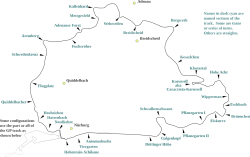24 Hours Nürburgring
 |
|
| Venue | Nürburgring Nordschleife |
|---|---|
| First race | 1970 |
| Duration | 24 Hours |
| Most wins (driver) |
Timo Bernhard (5) Pedro Lamy Marcel Tiemann |
| Most wins (team) |
Manthey Racing (5) Schnitzer Motorsport |
| Most wins (manufacturer) | BMW (19) |
The 24 Hours Nürburgring is a 24-hour annual touring car and GT endurance racing event on the Nordschleife (north loop) of the Nürburgring in central Germany. Held since 1970, over 25 km (15.5 mi) lap length allows more than 200 cars and over 700 drivers to participate.
Officially called ADAC 24h Rennen Nürburgring in German ('ADAC 24 hour Race Nürburgring'), it was introduced in 1970 by the ADAC as a real race, unlike the earlier endurance contests that covered 12, 24 (in 1961 and 1967), 36, 84 and even 96 hours, like the Marathon de la Route. This substitute for the Liége-Rome-Liége and Liége-Sofia-Liège rallies was held on the Nürburgring from 1965 to 1971.
It is similar to the Spa 24 Hours, which had been introduced in 1924, following the 24 Hours of Le Mans. The ADAC had held its first 1000 km Nürburgring sports car racing event in 1953. As the 1000 km Spa had been introduced in 1966, the 24h at the Ring gave both circuits a pair of endurance racing events at very long tracks, at least until Spa was shortened in the late 1970s.
Just like the VLN series with its 4-hour races, the 24h race is mainly aimed at amateurs, in order to fill a starting field of around 200 cars. Unlike the VLN races, the 24h is officially an international event, with bilingual (German and English) organization and documentation. Entry fees are due, in 2010 these were €7,508 per car, of which €3,000 was an advance payment for fuel. Typical entries range from second hand standard road cars to European Touring Car Championship vehicles and GT3 sports cars like the Porsche 911 GT3. The participation of manufactures and professional teams and drivers has varied over the decades. As spectator numbers had dropped in the 1990s when only rather standard FIA Group N cars competed, more spectacular vehicles were admitted since 1999, like the Zakspeed Chrysler Viper GTS-R which originally was built by Oreca to FIA GT2-spec, turbo-charged Porsche, modified Deutsche Tourenwagen Masters cars from Opel and Abt Sportsline-Audi, and the Schnitzer Motorsport-entered BMW M3 GTR V8 that had been run in the 2001 American Le Mans Series.
...
Wikipedia
